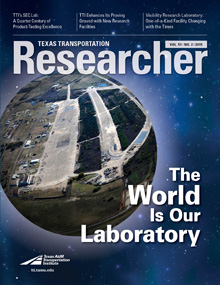Researchers these days are using computer simulations rather than actual testing environments to evaluate driving behavior. Why? For the most part, simulations are more cost effective and safer. However, reliably capturing reality in a simulated environment can be challenging.
In an effort to increase the realism of its driving simulator, the Texas A&M Transportation Institute (TTI) recently upgraded equipment to provide a more realistic simulated testing environment. With the improved simulator, researchers expect to see responses more consistent with real-life driving experiences — without the costs or safety issues associated with actual testing environments.

For a number of years TTI has had a driving simulator that didn’t require actually placing participants in a car. However, Mike Manser, manager of TTI’s Human Factors Program, said the outdated system looked more like a gaming setup and was unrealistic.
The new simulator more closely resembles the inside of a car and includes a regular vehicle seat, real pedals and three large monitors mounted on a frame to create a wide field of view for test subjects. With the addition of speakers, as well as a programmable dashboard to relay speedometer statistics and other information, the simulator creates a more realistic driving experience.
Other features include an eye tracker and software that researchers can use to create research scenarios involving automated vehicles. Smaller touch-screen displays complement the larger displays’ ability to convey connected vehicle information to drivers.
In the coming year, researchers will assess how effective systems are in providing feedback to drivers under a research grant from KPMG. This is just one of a number of areas TTI is studying to advance our knowledge of human-technology interaction.
“For example, we anticipate using the haptic steering wheel to provide force feedback [vibrations and motion to enhance the simulation],” Manser says. “We can provide unique information and warnings to drivers either through that steering wheel or through the small display screens.”
This modernized, more flexible simulator can now adapt to new research efforts to accommodate a wider range of research topics than could the older simulator.
“When you look at research across the spectrum, you need a variety of tools to answer different kinds of research questions,” Manser explains. “Our upgraded simulator gives us one of those tools.”
